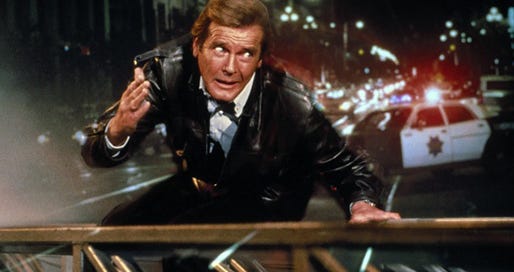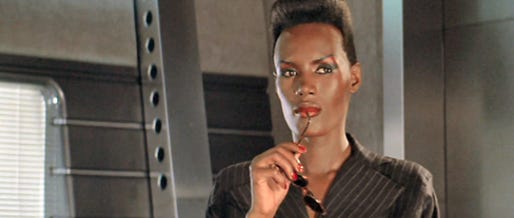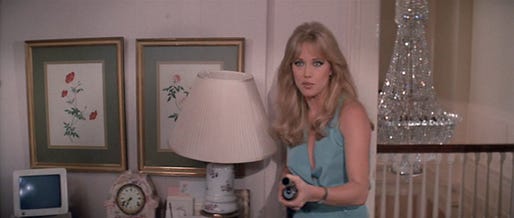You Only Live Twenty-Thrice: "A View to a Kill"
“You Only Live Twenty-Thrice” is a look back at the James Bond films.
Each Friday until the release of the 23rd official Bond film, “Skyfall,” we will revisit its 22 official predecessors from start to finish, with a bonus post for the unofficial films in which James Bond also appears.
Roger Moore returned for 1985’s “A View to a Kill” for several reasons — most notably a paycheck fattened with zeroes and the pursuit of a still-standing record to be the actor who officially played James Bond the most. The actor turned 57 while filming and even now asserts that he chose to leave afterward and wasn’t pushed out as producer Albert R. “Cubby” Broccoli insisted.
Age may be nothing but a number, especially with Hollywood’s help. But Moore’s 57 was significantly different than Bruce Willis, Denzel Washington or, to compare one of Moore’s contemporaries, Clint Eastwood. That Moore looked better suited to tea and crumpets than martinis and rumbles was a distraction in “Octopussy.” In “View,” the obviously swapped-in stuntmen is tinged with sadness — hardly a worthwhile sendoff for a seven-time Bond. The thing is that “View” could have used Moore’s age to its advantage in crafting an unexpectedly assertive swan song.
As a character, Bond’s most revealing moments find him grappling with human inevitabilities not even a suave secret agent can escape — death, rage, love. Why not have 007 at least tacitly acknowledge that time has robbed him of a step and laboriously summon the strength to stop a villain 20 or 25 years his junior — a more brash, punkish l’enfant terrible who not only disrespects Bond but put him through ultimate paces before meeting his demise? It’s here that one of the franchise’s coulda-shoulda casting calls could have made this a Bond of legend.
Max Zorin is an ubermensch as defined by Nazis, not Nietzsche. Genetically engineered for superior intelligence by Third Reich experiments that survived the fall, Zorin is an aggressively psychotic microchip magnate. And he’s turned on his KGB handlers — which include the usual suspect General Gogol (Walter Gotell) — to chart his own destiny: Flood Silicon Valley, kill millions, corner the microchip market forever.
“View” opens with a disclaimer that neither Zorin nor Zorin Industries are based on actual people or companies. It’s indicative of the creative life-support status that no one thought to check whether there was a company called Zoran Corporation, let alone one manufacturing chips in Silicon Valley.
Zoran would understandably want to distance itself from Zorin, as a more actively murderous megalomaniac 007 has never faced. One of his business associates learns the hard way that he should never trust a set of descending steps on an airship.
And in the most sustained scene of bloody violence in any Bond film to date, Zorin gleefully unloads Uzi clip after Uzi clip on laborers who have become loose ends — having laid thousands of explosives along the Hayward and San Andreas fault lines in a deep, underground mine.
Moore cited as a reason for his departure this scene’s alignment with Hollywood’s shift toward more graphic violence. But 007 sometimes must fight someone as macabre as he is manicured, a reminder of the evil against which Bond stands. Plus, of all the brutality over which to take a moral high ground, Moore chose fleeting moments of violence from, or against, villains— such as him kicking Locque’s car off a cliff in “For Your Eyes Only” — and not the more unnerving, degrading open-handed slaps he unnecessarily dished out to a few Bond girls.
Within the film’s PG confines, this is a memorably unsettling turn from Christopher Walken — the third of four Academy Award nominees / winners to play a Bond villain, counting “Skyfall’s” Javier Bardem.
But imagine David Bowie’s sophisticatedly dismissive deadpan or Sting’s raw, sneering impudence. Both were courted before Broccoli went after Walken and both could convincingly exude disdain for Bond’s goody-two-shoes, arrogantly and snidely rejecting this elder. Over their Zorins, Bond’s victory could prop up nobility unbound by age and validate a devotion to heroism — solidify a legacy. Walken is younger than Moore, yes, but that gap is far from generational.
Ever the spontaneous, wackadoo oddball, Walken simply upstages Moore — treating kickboxing as foreplay, tapping a gun barrel to his head as a callout to his Oscar-winning role in “The Deer Hunter,” injecting maniacal laughs into his halting cadence, and even flashing a smile as he plummets into the San Francisco Bay.
The closest “View” comes to challenging Bond’s traditional ideas of dominance arrives in a rough-and-tumble sex scene. Otherwise, rather than capitalizing on his leading man’s advancing years, director John Glen enters blandly utilitarian territory. Bond gets a “cool” leather jacket as one of several feeble attempts to make him seem more youthful.
007 fends off foes by snowboarding in a pre-credits scene that forgoes ski-sequence director Willy Bogner’s traditionally hard-packed action for a more powdery consistency. Either to hide bags or eyes permanently beady from botched plastic surgery, Moore is wearing sunglasses, and he hangs 10 on the slopes to a horridly synthed-up cover of “California Girls.”
Thankfully, “View’s” music improves immensely from there, especially in a Bond theme that — in a mirror image of Paul McCartney’s “Live and Let Die” — feels dangerous, urgent and fresh, with lyrics that carry portentous, poetic weight.
Duran Duran bassist John Taylor allegedly approached Broccoli at a party and boozily asked him when he would get someone “decent” to record a Bond theme. Collaborating with John Barry, the band recorded “A View to a Kill” — the only Bond theme to hit No. 1 on the Billboard Hot 100 charts and the last track all five original members of Duran Duran would perform together until their 2001 reunion.
It would be sufficient that Duran Duran and Barry successfully fused 1980s New Wave with 1960s classicism, and Barry crafts instrumental arrangements of the melody for the film that are alternately lovely and playful. But they created a classic with a notably harder edge than the movie it accompanies.
Ominous percussion gives way to staccato orchestral blasts paced like a shiv to the side. Singer Simon Le Bon works himself into an upper-register frenzy with immediacy. And its lyrics are chillingly evocative:
“The first crystal tears fall as snowflakes on your body First time in years to drench your skin with lover’s rosy stain A chance to find the phoenix for the flame A chance to die, but can we dance into the fire That fatal kiss is all we need Dance into the fire to fatal sounds of broken dreams”
Invigorated by the song’s intensity, opening-credits designer Maurice Binder matches its propulsive nature. Although not terribly far off from a Duran Duran video, it’s a passage as nightmarish as it is sensual, driven by the lyrical dichotomy of ice and fire. However, transitioning from these credits to a formally dressed guard on a horse serves only to punctuate the odd disconnect at “View’s” center.
Bond films typically feature other British agents getting whacked in short order, but “View” pairs 007 with an MI6 buddy in its first act. Again, it could have been a younger sort raring to go who challenges Bond. Instead, it’s an erstwhile horse trainer named Sir Godfrey Tibbett, played by Patrick Macnee, five years Moore’s senior.
Macnee played John Steed in Great Britain’s blockbuster TV hit “The Avengers,” so it’s a kitschy stunt pairing actors to play stiff-upper-lip, queen-and-country heroes. Together, they waste their time at Zorin’s estate investigating his horse-doping scheme. (Bond gets on Zorin’s trail after his ski mission yields the recovery of a Soviet copy of a Zorin microchip designed to withstand an electromagnetic pulse.)
Bond and Tibbett find Zorin’s horses, which always win, are embedded with steroidal microchips, remote-controlled by jockeys’ whips. Unnecessarily long and forgotten once it’s solved, this mystery exists exclusively for Macnee to hang around a hair longer than the average Double-Oh agent. And why would Zorin expend so much time and energy on this endeavor when he’s planning to flood Silicon Valley? Like Auric Goldfinger and Kamal Khan before him, Zorin is a notorious cheat at gentleman’s games, but those traits were explained in five minutes, not 25.
However, it’s at Zorin’s estate that “View” offers the most interesting sex scene in 23 years of Bond films — a fleeting glimpse at 007’s fragile nature in Moore’s aging hands.
With a physical appearance both androgynous and avantgarde, Grace Jones had been a model, a musician blending electronica with R&B and a muse to Andy Warhol. After her appearance in 1984’s “Conan the Destroyer,” Jones was also a muscular female action star.
As May Day, Zorin’s henchwoman and lover, Jones is introduced wearing a hat that looks like a photographer’s hood. She later wears a thong singlet during a kickboxing spar with Zorin. And dressed like a haute couture version of the Black Knight from “Monty Python and the Holy Grail,” she leaps from the Eiffel Tower.
With close-cropped hair puffed into horns and her deep, mannish laugh, Jones’s untraditional blend of sexiness, strength and scariness gives “View” a jolt. But it’s no more apparent than when Zorin, pimping her out to Bond while a guest of the estate, sends her to the agent’s bedroom. Zorin does this to keep up the appearance of a gentlemanly host, but there’s nothing gentlemanly about May Day’s approach to sex. It may look like her steeliness will go squidgy in Bond’s arms. But May Day roughly tosses Bond to the bottom and gives him a grind that emits grandfatherly groans of penile pain from Moore. For the first time ever in a bedroom, 007 looks a bit helpless.
Left to die by Zorin in the mine, May Day comes around to Bond’s thinking like Jaws before her. Ultimately, there is something poignant to the resignation and resolve in May Day’s eyes as she chooses to sacrifice herself for the greater good. In but a few minutes of screen time, Jones creates an iconic villainous Bond lover and foe.
In Jones’s wake, sleepy-eyed, throaty-voiced Tanya Roberts doesn’t stand a chance as Stacey Sutton — the “good” Bond girl and woman whose family oil business Zorin seeks as a facet of his evil plan.
Roberts’ only believable scene is one in which she eats a quiche James has baked for her. This bit is an undoubted shot at “Real Men Don’t Eat Quiche,” an early ’80s testosterone manifesto written by humorist Bruce Feirstein, who would go on to co-write three of Pierce Brosnan’s four Bond films.
Otherwise, Roberts flashes the same milquetoast facial expressions to convey seduction and exasperation. Plus, Stacey is a whiny, whimpering feeb who seems to think 007 will just leave her behind in a burning elevator shaft.
Although the stuntmen (again) look nothing like Moore, their work is a bright spot in “View,” whether Bond drives a car that’s been cut in half or dangles from the ladder of a speeding fire engine. But, as a 130-minute exercise in taking the good with the bad, the fire-engine scene features flatfoots who feel like big city, Keystone Kops cousins to Sheriff J.W. Pepper.
It’s also the rare Bond movie that ends with a more vague assertion of his return, omitting the custom of naming the adventure in which we’d see him next. It’s indicative of the infrequency with which audiences would see 007 over the next decade — Broccoli would only give twice — and the uncertain situation in which Moore had left them for moving forward.
Although contrary to almost everything I’ve written about “A View to a Kill” so far, neither time nor a relative lack of quality can fully harden my soft spot for the film. It’s not the greatest James Bond film — not even close — but at 6 years old, it was my first, and I’ll always relish it as my introduction to improbable stunts, unflappable coolness and, well, what sex was (at least in the movies). Hell, it’s probably the very reason I’m writing this series of articles.
There are apples-and-oranges elements to every Bond comparison, even though most of us have our favorite. Contrary to historical opinion and despite some truly awful movies, Moore conjured some roguish magic over his 12-year tenure. His Bond cast the spell that initially charmed me as a kid — one that perhaps proved so intoxicating to him that it was simply hard to let go.
Next week: "The Living Daylights"
BULLET POINTS
“A View to a Kill” is actually the third Bond film in which Maud Adams appears. After co-starring in “The Man with the Golden Gun” and “Octopussy,” she filmed a blink-and-miss-it cameo in San Francisco. Conflicting reports either peg her as a woman disembarking a trolley or strolling behind 007 and David Yip on Fisherman’s Wharf.
"A View to a Kill" marks the screen debut of Swedish headknocker Dolph Lundgren. Later that year as Ivan Drago in "Rocky IV," Lundgren would instantly embody the "bad" side of the Cold War for American 6-year-olds. But at the time, he was just Grace Jones's boyfriend, and she got him a scene as one of General Gogol's bodyguards.
In June 1984, several cans of petrol used to film Ridley Scott’s “Legend” caught fire and burned down the legendary “007 Studio” at London’s Pinewood Studios. The studio was rebuilt from the ground up by January 1985, in time to film select scenes for “A View to a Kill.”
When James and Stacey enter Zorin’s mine wearing overalls, the script called for them to wear unflattering, loose-fitting miners’ overalls. Tanya Roberts allegedly locked herself in her trailer until she received custom-tailored overalls. When Roger Moore ad-libs “Lucky you could find one that fit,” Roberts’ dirty look is for real.
The end titles of “Octopussy” are technically incorrect in reading “James Bond will return in ‘From a View to a Kill’.” Although that’s the title of Ian Fleming’s short story, producer Albert R. “Cubby” Broccoli dropped the word “From” several months before filming commenced.





